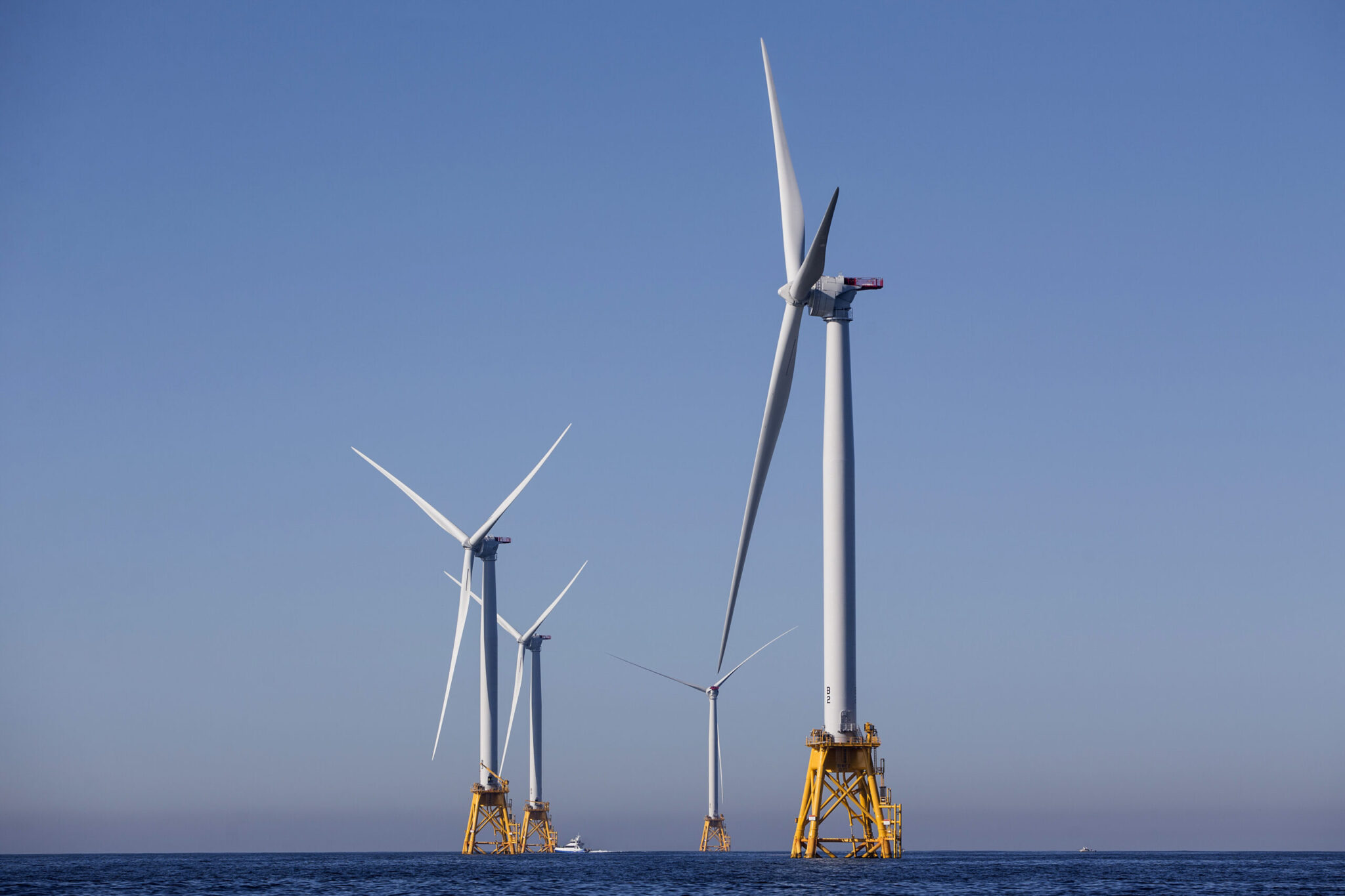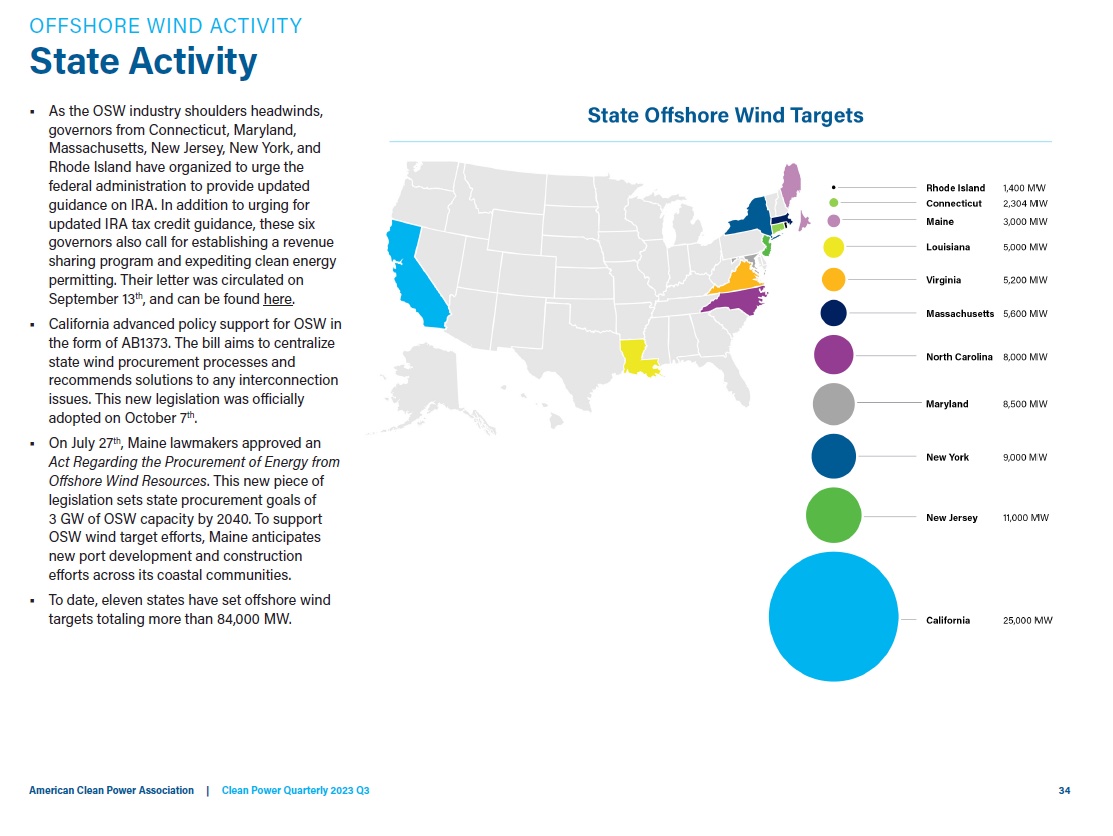As industry struggles, federal, state offshore wind goals could get tougher to meet

Good news or bad news first? Because there was plenty of both this week for the fledgling U.S. offshore wind industry.
On Halloween, the Biden administration announced that the nation’s largest planned offshore wind development, Dominion Energy’s 2,600 megawatt Coastal Virginia Offshore Wind project, received its last major federal approval.
That night, however, Danish wind giant Ørsted pulled the plug on a pair of projects (Ocean Wind 1 and 2) that were planned off the coast of New Jersey, citing climbing interest rates, inflation and “supply chain bottlenecks.” The news touched off a firestorm in New Jersey, which has set some of the most aggressive offshore wind goals in the country and gone to considerable lengths to plan the transmission upgrades needed to bring all that power ashore.
Ørsted is one of two companies planning offshore wind installations off the coast of Ocean City in Maryland. At the bottom of its statement Tuesday night about its decision to abandon New Jersey, Ørsted restated its commitment to the Maryland project, known as Skipjack Wind, but said, cryptically, that the company “continues to reconfigure this project and expects to have more clarity on its path forward in the coming months as discussions continue with stakeholders in Maryland.”
The same financial headwinds have many U.S. offshore wind developers looking to renegotiate deals as the costs of their projects climb. And it’s casting some doubt on whether states and the Biden administration will be able to hit their offshore wind targets on time.
Maryland expanded its offshore wind lease areas and energy-producing targets just this year. State officials have also envisioned new steel and production plants at the Tradepoint Atlantic industrial development in Dundalk serving the offshore wind energy not just in Maryland, but throughout the Mid-Atlantic region.
A ‘sharp increase’ in costs
John Murray, a senior research analyst at S&P Global Commodity Insights, said the affected projects secured deals to purchase their power between 2019 and 2022, noting that during that period there were lower financing and capital expenditure costs.
“The sharp increase in inflation (starting in 2021), due to increased demand, has led to price rises in raw materials (such as steel, copper and aluminum) that are essential to the construction of wind turbines. Labor costs for engineers, construction and manufacturing workers have also risen significantly. Developers have been reporting project cost increases anywhere from 10-50%,” Murray said.
Eleven states across the country, mostly along the Eastern Seaboard, have set their own aggressive targets for offshore wind development, according to a report issued Wednesday by the American Clean Power Association. Other states, everywhere from Delaware and South Carolina to those touching the Great Lakes, are also exploring encouraging offshore wind development. And the Biden administration has set a goal of 30 gigawatts of offshore wind by 2030, the rough equivalent of more than 30 large power plants.

A graphic showing individual state offshore wind targets. (American Clean Power Association 3rd quarter 2023 Clean Power Quarterly report)
A spokesperson for S&P Global, a financial and industry data firm, said it is “downwardly revising” its estimates of offshore wind development by 2030 in a coming report “due to recent industry announcements.” The current outlook anticipates 22 gigawatts by 2030.
The industry’s woes have hardly been a secret. At an industry conference in Boston this summer, there was plenty of gloom to go around and the same complaints about inflation, rising labor and materials costs and permitting delays. But even so, the decision by Ørsted came as a surprise to New Jersey Gov. Phil Murphy (D) — who said that “as recently as several weeks ago, the company made public statements regarding the viability and progress of Ocean Wind 1” — and spread concern across the industry.
Sam Salustro, a vice president at the Baltimore-based Oceantic Network, a trade group formerly known as the Business Network for Offshore Wind, said it was “extremely disappointed to hear of Ørsted’s decision,” though it added the cancellations were triggered by “financial difficulties experienced across the industry which serves as a reminder of the hard work we need to do building a supporting supply chain.”
Jason Ryan, a spokesperson for the American Clean Power Association, said Halloween was a “day of highs and lows for the U.S. offshore wind industry. He noted that, despite the termination of the New Jersey projects, work is going forward on Vineyard Wind 1, a development off the coast of Massachusetts by Avangrid Renewables, as well as South Fork Wind, a partnership between Ørsted and Eversource, a New England utility company, off the coast of Long Island in addition to the Virginia project receiving federal approval. Though it canceled the New Jersey projects, Ørsted also said it would move ahead on Revolution Wind, a 704 megawatt joint venture with Eversource planned to deliver power to Rhode Island and Connecticut.
“While the news out of New Jersey is a disappointment, our industry continues to show its resilience and the path ahead for the clean energy transition remains promising,” Ryan said. “The news is also a reminder that we need strong partnerships with government and stakeholders, now more than ever.”
Virginia project moves ahead
Bucking the industry trends, though, Dominion Energy says its nearly $10 billion Coastal Virginia Offshore Wind project is on time and on budget. Jeremy Slayton, a company spokesperson, said the Bureau of Ocean Energy Management’s record of decision, the 2,600 megawatt, 176-turbine project’s “last major permitting milestone,” will allow some onshore construction to start. It’s scheduled to be finished by 2026.
“You can look to our project and see that offshore wind is moving along very well here in Virginia under our regulated process,” Slayton said.
Coastal Virginia Offshore Wind is different from many of the other projects in the Northeast in that Dominion holds the federal offshore wind lease and is spearheading the project itself — although legislation passed by the state’s General Assembly this year allows it to “establish an offshore wind affiliate … for the purpose of securing a noncontrolling equity financing partner for the project.”
Slayton said that because the project, proposed in 2019, had to be approved by the utility regulators at the State Corporation Commission, the company had to secure its major contractors, production slots, prices and other costs early.
“We locked in those costs before supply chain issues, before interest rates went up,” Slayton said.
However, there was some wrangling in the state between utility regulators, consumer advocates and the utility over ratepayer protections. The project was ultimately approved by the utility commission last year with what Will Cleveland, an attorney with the Southern Environmental Law Center, said are important protections to shield electric customers.
“In a project like this there are two fundamental types of risk. One is construction risk, where the project ultimately costs a lot more or a lot more time to build than originally estimated,” Cleveland said. “The other risk is operational risk where the project does not perform nearly as well as promised.”
Ratepayer advocates had initially sought a performance guarantee, but after negotiations that also included the state’s attorney general, the company agreed to a construction guarantee that means if cost overruns exceed certain thresholds, “the shareholders will have to pick up the tab,” Cleveland said.
“They locked in a lot of their supply contracts at fixed prices a while ago. By doing so Dominion insulated itself and its shareholders from a lot of these cost increases these developers are seeing,” he said. “They felt better able to manage the construction cost than the operational risk.”
However, Cleveland said traditional power purchase agreements, which are how most offshore wind developers have sought to make money from the power produced, are generally lower risk for customers.
“If you’re going to go the utility-ownership model, it’s imperative the utility regulator has the power to protect customers from the risk of that model and the Virginia commission did it right this time.”
Getting ‘back on track’
Murray, the S&P analyst, said the current “state of flux” in offshore wind is “something that is not uncommon for a new industry.”
Utility companies in some cases have terminated existing power purchase agreements at the request of wind developers and in others have refused to go into contracts deemed too costly. According to Reuters, by mid-September developers of at least 10 East Coast projects were seeking new power purchase agreements. Just last month, New York’s Public Service Commission rejected a bid by wind developers to renegotiate deals with the state
Despite the Ørsted cancellations, he noted that New York’s latest solicitation for offshore wind power, in which the New York State Energy Research and Development Authority picked three new offshore wind projects totaling 4,032 megawatts, shows that “developers are still keen on moving forward.” Murray added that the federal government is trying to speed up offshore wind permitting and New York is “showing the way forward” by considering stepping up the pace of its solicitation process.
“Although New York denied petitions to renegotiate offtake contract prices, speeding up the solicitation process signals that New York state regulators acknowledge the industry’s pricing concerns and wants to help developers get their project economics back on track as soon as possible,” Murray said.
Maryland implications
Asked this week to clarify Ørsted’s posture on its Maryland proposal, Maddy Voytek, head of Government Affairs and Market Strategy for Maryland, reiterated, “Ørsted continues to develop Skipjack Wind and expects to have more clarity on its path forward as we continue discussions with stakeholders in Maryland and Delaware.”
As part of the legislation expanding Maryland’s offshore wind goals, lawmakers included a measure allowing the state’s Public Service Commission, which regulates utilities, to lift the cap on wind developers’ ability to receive federal incentives.
In a statement provided to Maryland Matters this week, Paul Pinsky, director of the Maryland Energy Administration, said that in order to dampen the impact of changing economic conditions in the industry, Ørsted has formally requested a waiver from the state legislative restriction to only receive 20% of any new federal dollars earmarked for its Ocean City project. Ørsted is requesting a full waiver, he said, which would allow the company to receive 100% of any earmarked federal funds.
“We hope to keep momentum and the planned construction of the project moving,” Pinsky said. “We would like to avoid the interruptions witnessed in the Atlantic coastal states, but we also want to remain vigilant of any additional costs shouldered by ratepayers. It seems the dynamic of offshore wind development has, indeed, shifted: Years ago, the risk fell to the wind developers, whereas now it seems the risk is being shifted to the states and ratepayers.”
Meanwhile, the federal government is taking comments through mid-November on the draft environmental impact statement for the other offshore wind project in Maryland, developed by a second company, US Wind. This is considered a significant sign of progress.
“US Wind passed a major milestone last month when the federal government released the draft environmental impact statement of our construction and operations plan,” said Nancy Sopko, US Wind’s senior director of external affairs. “Our main focus now is to complete the permitting process in 2024 so we can move toward construction. We believe that our MarWin project will be Maryland’s first offshore wind farm and we continue to invest to make that a reality.”
Jamie DeMarco, Maryland director for the Chesapeake Climate Action Network, called Ørsted’s decision to pull out of New Jersey “bad news,” but said it shouldn’t have much impact in Maryland.
“The big picture is that the offshore wind industry is still booming in the United States and is going to grow by orders of magnitude,” he said. “Sometimes individual projects at the early stage of development don’t make it.”
Pinsky said Maryland officials are still convinced that offshore wind “is the state’s largest potential renewable energy resource.”
“There are more chapters yet to be written and Maryland remains committed to staying at the table in our pursuit of a clean energy environment,” he said.





 Creative Commons Attribution
Creative Commons Attribution